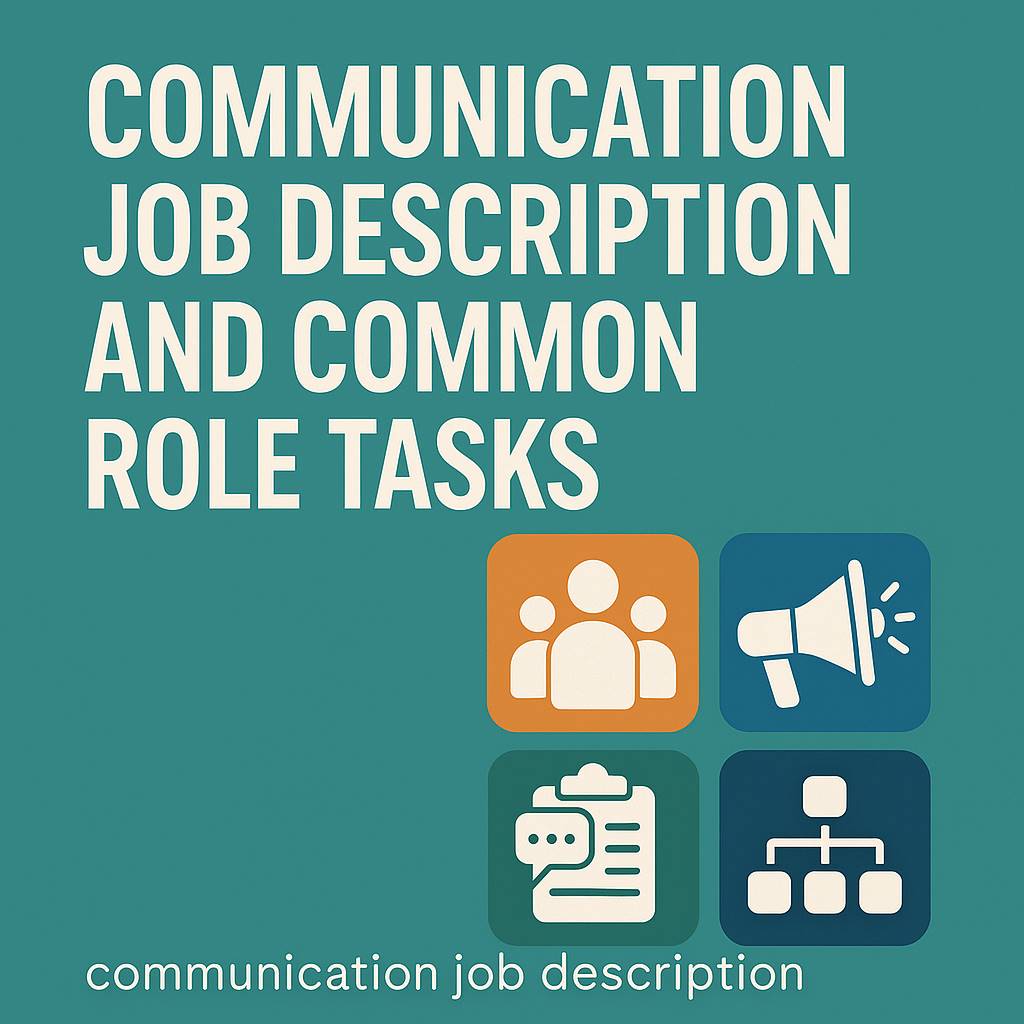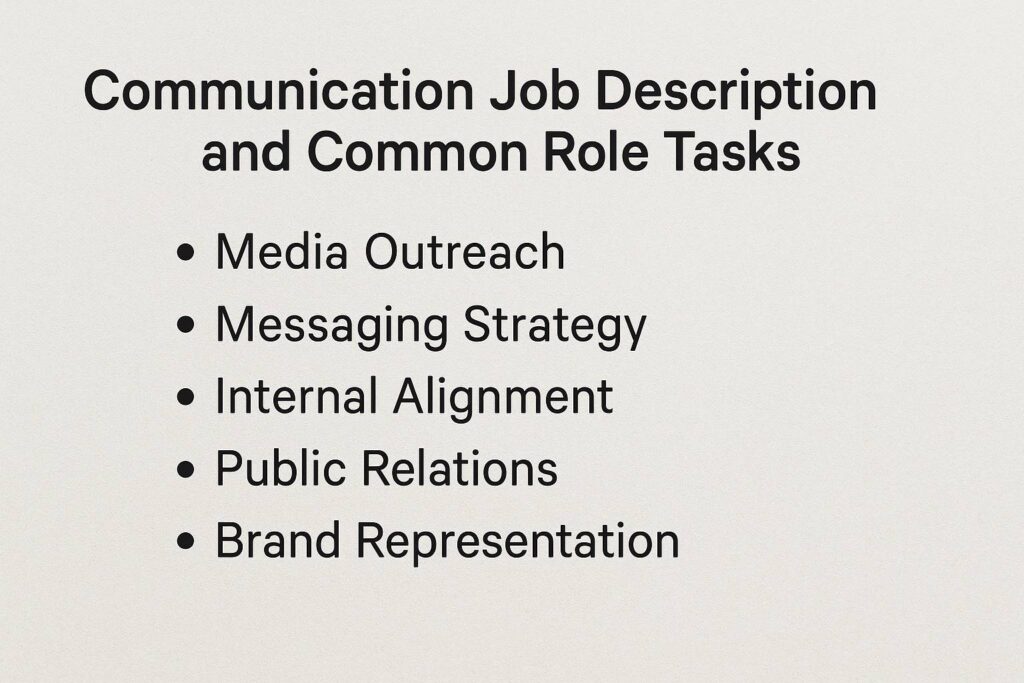
Amanda White
June 16, 2025
No Comments
Understanding the Key Responsibilities in a Communication Job Description
A well-crafted communication job description is essential for setting expectations and attracting the right talent. A communication professional’s role involves far more than simply writing press releases or managing social media accounts. In fact, the modern communication job description often spans media relations, internal messaging, crisis management, and brand development. These multifaceted tasks require a strategic mindset and an agile approach.
Among the key communication officer duties, professionals are expected to shape narratives that reflect the organization’s values and objectives. They ensure messaging consistency across internal and external channels. This includes aligning with marketing teams on campaigns, working with HR on internal announcements, and collaborating with C-suite executives on corporate speeches or public addresses. This cross-functional coordination ensures the company voice is coherent and aligned with its brand.
Let’s consider a few examples of roles in action. A global manufacturing company might require its communications team to manage product launch announcements in multiple regions, tailoring messaging to cultural and market nuances. Meanwhile, in a tech startup, the communication lead could focus heavily on investor relations and digital branding.
If you’re interested in teaching or coaching business English professionals, this Guide to Teaching English Communication Effectively highlights essential strategies for training communication leaders.
From email newsletters and press kits to public events and crisis statements, the communication job description encapsulates a wide range of mission-critical responsibilities. When executed effectively, it boosts employee engagement, strengthens brand identity, and protects corporate reputation.
Table of Contents
Identifying Core Communication Officer Duties in Daily Operations
In today’s interconnected world, communication professionals wear many hats. The communication job description frequently includes responsibilities such as stakeholder engagement, employee communication, and reputation management. Their daily work is dynamic, with tasks shifting based on internal priorities and external developments.
One of the most consistent communication officer duties is content creation. This includes drafting internal memos, executive messages, and marketing assets. The role also involves gatekeeping brand tone and messaging clarity. Professionals in this field must be vigilant editors, ensuring every piece of content reflects corporate values and objectives.
A growing area is the marketing communication role, especially in digital environments. Communication teams are collaborating more with sales and digital marketing units to unify customer experience across touchpoints. They use analytics to measure campaign effectiveness, adjusting messages to resonate with target audiences.
Additionally, communication officers often manage partnerships with media outlets, organize press briefings, and build relationships with journalists. These public-facing duties demand emotional intelligence and political savvy.
Check out this insightful article on External Communication Definition and Business Examples to better understand how organizations interact with outside audiences.
To build strong communication fluency, many professionals now opt to Learn English with online English teacher, enabling them to meet the demands of global roles more effectively.
Exploring the Marketing Communication Role within Corporate Teams
The line between communications and marketing continues to blur. As such, professionals responsible for a company’s image are often involved in the marketing communication role. This role focuses on promoting brand visibility, ensuring message alignment, and contributing to lead generation efforts.
One prominent aspect of this role is campaign integration. Communications experts must coordinate product messaging, digital campaigns, and public relations initiatives. They develop taglines, craft product descriptions, and manage branded content across platforms. It’s vital that all these touchpoints reflect a unified voice.
This unity extends to managing internal communication tasks that support marketing goals, such as educating employees about new offerings or sales strategies. Staff who understand campaigns internally are more likely to act as brand ambassadors externally.
A successful marketing communication strategy hinges on consistent monitoring of audience sentiment. Whether through social listening tools or direct customer feedback, these insights allow companies to refine their approach.
For a deeper dive into brand communication, explore this guide on How Branding Communication Builds Strong Business Identity.
The communication job description in this context is not just about messaging — it’s about aligning words with business goals. By understanding how their work feeds into marketing ROI, communication professionals can demonstrate their value to leadership.

Effective Internal Communication Tasks Every Team Needs
One of the lesser-publicized but most crucial aspects of the communication job description is managing internal communication tasks. This work ensures all employees—from interns to executives—are informed, aligned, and engaged.
These tasks include writing internal newsletters, creating CEO updates, and managing employee town halls. In larger organizations, this might also involve crafting onboarding communications and building knowledge-sharing platforms. Internal communicators often serve as the bridge between leadership and staff.
Given the increasing complexity of remote work, companies rely heavily on internal communications to maintain connection and morale. Whether it’s a Slack announcement or a weekly video message, every communication touchpoint affects corporate culture.
This area of responsibility also ties closely to communication officer duties, especially during times of change or crisis. During a merger, for example, internal communication becomes a lifeline for employees seeking clarity.
Explore What Corporate Public Affairs Means for Modern Companies to learn how internal and public affairs intersect in times of organizational change.
An effective internal communication strategy contributes directly to employee satisfaction and productivity. It’s the glue that holds teams together.
Public Relations Job Scope: Building and Nurturing External Reputation
The public relations job scope is a vital extension of the communication role, encompassing media relations, crisis response, and stakeholder communication. It’s about shaping perception and preserving trust.
Public relations professionals act as the company’s public face, engaging with journalists, writing press releases, and coordinating speaking engagements for executives. They also manage the company’s response to crises—from product recalls to leadership controversies—ensuring the message is swift, clear, and empathetic.
Their responsibilities overlap with corporate communication responsibilities and often dictate how a brand is viewed by investors, customers, and the general public. Media training, strategic planning, and performance metrics are essential tools in this domain.
Successful PR teams work in lockstep with marketing and legal teams. This ensures the narrative is not only compelling but also compliant and aligned with corporate strategy.
Their work supports the broader communication job description, particularly in managing brand integrity and external visibility. Communications professionals who excel in PR often possess a blend of analytical and creative skills.
Corporate Communication Responsibilities and Strategic Alignment
At the highest level, corporate communication responsibilities involve shaping the overarching messaging strategy of an organization. This includes setting tone guidelines, supervising communication channels, and ensuring consistency across regions and languages.
Strategic alignment is a key goal. Communications leaders work closely with executives to translate vision and mission into actionable narratives. They craft speeches, manage quarterly reports, and influence corporate storytelling.
These professionals also oversee internal communication tasks to ensure staff are not just informed, but inspired. They may lead initiatives that tie employee feedback into policy changes, demonstrating that communication is a two-way street.
In the context of the marketing communication role, they ensure synergy between internal enthusiasm and external promotions. Their job is both macro and micro—balancing long-term brand strategy with day-to-day messaging needs.
The modern communication leader is part editor, part strategist, and part diplomat.
Evaluating the Skills and Qualifications Required for the Role
What does it take to thrive under a communication job description? Beyond writing skills, professionals in this space need storytelling talent, strategic thinking, and cross-functional collaboration abilities.
Successful candidates typically have backgrounds in journalism, public relations, or marketing. However, as roles evolve, experience in digital communication, behavioral psychology, or even data analytics is becoming increasingly valuable.
Understanding communication officer duties means recognizing the need for adaptability. Communication emergencies arise without warning. The best professionals remain calm under pressure and adjust strategies in real time.
To see how language and culture play a role in communication roles, explore our Contact Us | CorporateEnglish.biz page to learn about our training programs for communication professionals across the globe.
Whether they’re managing public relations job scope challenges or guiding teams through internal transformations, skilled communicators are indispensable in today’s business world.
Latest Blog
More on Corporate Communication

Corporate Communications Job Description and
Corporate communications job description includes internal messaging, media handling, and strategic branding roles for



Why Corporate Communications Careers Are
Corporate communications careers are in high demand as companies seek better branding, messaging, and



Choosing the Best Corporate Communication
Corporate communication solutions include digital platforms and tools that streamline internal messages and improve







